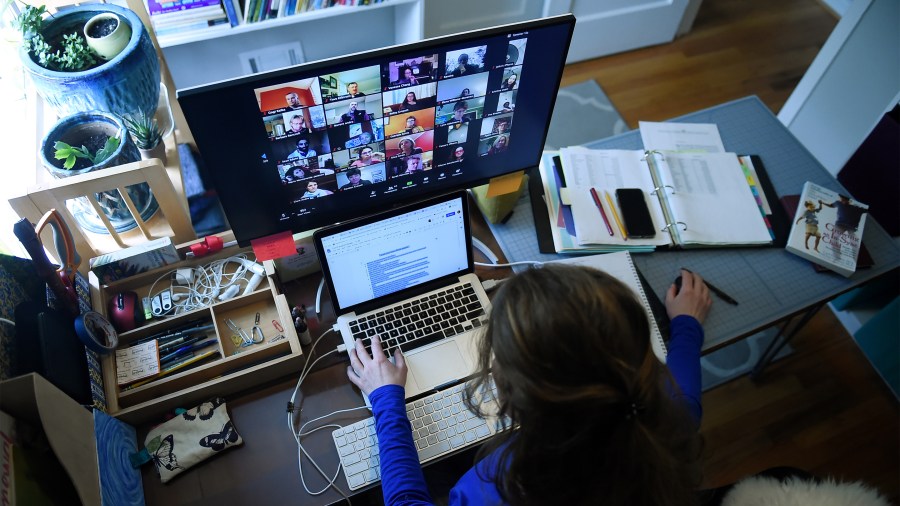Online learning tools aren’t as accessible for students with disabilities

Remote learning this year is an ongoing challenge from kindergarten all the way to college. And much of the technology that connects students and teachers isn’t optimized for people with disabilities. A Zoom meeting can look very different if you use American Sign Language, for example.
“You see how the light keeps kind of flashing and changing as I move?” said Julie Hochgesang, a linguistics professor at Gallaudet University. Her laptop’s camera adjusts focus as she signs, moving her hands closer or farther away from the lens. It makes it seem like the lights are flickering in her living room.
“My students have to watch an hour of this flickering of light behind me. Maybe a minute or two is fine, but the constant flickering becomes quite exhausting on the mind and eyes,” Hochgesang said.
She bought a more customizable external camera for this new semester that should take care of the flickering, but then there’s the video chat software itself. Zoom and others focus on the person speaking out loud, so someone asking a question in ASL wouldn’t get highlighted. And putting everyone in a grid creates tiny boxes, where it’s hard to see people’s hands.
“I wish that Zoom would let us set up who we can have on screen. It really changes my ability to interact with students,” Hochgesang said.
Zoom said it will have new features to help with classroom management later this month based on “feedback from the education community.”
Even for tech that can be made accessible, there’s the cost. Cyndi Wiley is the digital accessibility lead at Iowa State University. They say virtual lectures need to be captioned, but since automatic transcription tools aren’t accurate enough to meet federal standards, schools need to pay for human captioners. “To achieve 99% accuracy with a live human editor in a class, it’s going to be around $1 a minute,” Wiley said.
Professors also need to put HTML headings in their materials to work with screen readers, which can cost thousands of dollars per class. “Remediation is always going to be more expensive than it is to have an established process in line from the very beginning,” Wiley said.
Some K-12 school districts buy learning-management programs, in which teachers can post worksheets and videos and students can upload homework. But some programs don’t allow kids to print out materials.
“Students that physically need to be able to write and can’t do it through their screen very easily are not going to be able to engage in doing a traditional worksheet,” said Liz Kolb, a learning technologies professor at the University of Michigan. “That is problematic.”
Kolb mentioned Seesaw, a popular learning management program for elementary schools, which didn’t allow printing. She also said it isn’t compatible with screen readers for students with low vision.
Seesaw did add the ability to print this week, according to co-founder and Chief Product Officer Carl Sjogreen. He said Seesaw’s buttons and instructions support screen readers, but the app doesn’t allow teachers to include alt-text descriptions for the pictures they upload.
“Right now, we don’t support that kind of thing,” Sjogreen said. “But I think it’s the kind of thing that we’re looking at as we try and figure out how to get better at this. It’s definitely not something that I think we consider a solved problem, nor do I think has anyone else in the education technology realm solved with this kind of more visual, elementary-aged learning content.”
Kolb, at the University of Michigan, said even the most accessible tools won’t be as effective as in-person instruction for some students. “It’s still not the same as having a teacher or a support person sitting next to you and working through things together with you, or helping you turn the pages of a book,” she said.
With millions learning online-only this fall, that could leave those students behind throughout the pandemic.
Related links: More insight from Kimberly Adams
KQED’s MindShift has a detailed look at how designing for accessibility in education can make learning more equitable for all students.
Marta Jewson, who covers education in New Orleans for The Lens, has a piece on the challenges for special education in New Orleans schools during the pandemic, which are probably a lot of the same challenges school districts all over the country are trying to figure out at this very moment.
The future of this podcast starts with you.
Every day, the “Marketplace Tech” team demystifies the digital economy with stories that explore more than just Big Tech. We’re committed to covering topics that matter to you and the world around us, diving deep into how technology intersects with climate change, inequity, and disinformation.
As part of a nonprofit newsroom, we’re counting on listeners like you to keep this public service paywall-free and available to all.
Support “Marketplace Tech” in any amount today and become a partner in our mission.


















